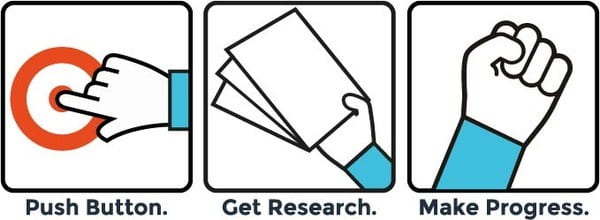Open Access Button
By Kirsty, on 26 March 2020
One of the most frustrating aspects of doing research is when you come up against an article you can’t get at without paying. Even with the wide range of databases and journals that the library subscribes to, coverage is not complete. JISC, SPARC, Open Society Foundations, the Centre for Open Science and many others have worked together to create a solution to this problem called the Open Access Button.
What does it do?
The Open Access Button tool tells you if there are free (and legally available) copies of articles available as you go along – without you having to search them out. The tool, once installed, searches an extensive collection of existing repositories and aggregators in the background of your browser and indicates when it finds an Open Access version of something using a discrete icon on your screen.
They also provide another option – a button that you can install on your browser to run a quick search for Open Access versions of something.
Why do I need it?
The Open Access Button team support the Open Access movement and believe that outputs of publicly funded and supported research should be openly and freely available for use by the public and by other researchers.
There has been a lot of work in the last few years to increase the amounts of Open Access content available online. The number of works which are available open access is growing every day, but many are still only available to those that can pay subscriptions. Not only does this mean that only rich institutions can have access to the results of research, but also, public resources that could be used to develop research are spent just to read the work that has already been undertaken.
The role of the Open Access Button is to make it easier to access works already freely available by allowing a single point of search for the numerous repositories out there, assuring what you find is legal and from a reliable source. At the same time, it is identifying restricted works and working with researchers to release their full potential for the public good by allowing you to request copies of works that are not yet Open Access.
How does it work?
When you find an article, the Open Access Button tool uses the information on the page (the bibliographic metadata) to search its approved sources for an open Access copy of the work. Sources include most of the major global aggregated repositories. Such as:
- OA DOI which provides the data behind Unpaywall, an app that leads straight to legitimate author uploaded versions of the publisher’s articles like the OA Button.
- SHARE, a US service developed by the Association of Research Libraries in partnership with the Center for Open Science
- CORE which offers “seamless access to millions of open access research papers, enrich the collected data for text-mining and provide unique services to the research community.”
- OpenAIRE, a European resource that offers an OA search engine and a campaign platform driving Open Access development and policy.
- Dissemin, a French resource with a slightly different approach: “ Dissemin searches for copies of your papers in a large collection of open repositories and tells you which ones cannot be accessed”
- Europe PMC which specialises in life sciences research
- BASE a Germany based aggregator.
In addition, if you ask the Open Access Button to search for an article that is not available openly, a request is sent to the author asking them to share. The service is able to support the authors in sharing the article quickly and legally.
Is it legal?
The Open Access Button will only show you legal, freely available copies. Your assurance of this comes from the sources they use and the supporters of the initiative. These include:
- JISC
- SPARC (Scholarly Publishing and Academic Resources Coalition)
- Open Society Foundations
- Center for Open Science
How can I get it?
Check your Browser
Open Access Button works with Chrome, FireFox and Safari. It is less successful with Internet Explorer or Microsoft Edge.
Ways to use the Open Access Button
- Use the Search Engine: On the homepage, enter any part of a bibliographic citation and the search engine will seek out an open access copy – if one exists.
- Use the Button: Add the Open Access Button extension for unpaywall to your browser. Whenever you land on a journal abstract page for a work or find a reference in Google scholar the icon on the right-hand-side of your screen will tell you if the work is available and why. If the work was self-archived on an institutional, funder or subject repository, then the icon will be green, if it is open access on the publisher pages, the icon will be Gold-coloured. If it doesn’t automatically identify the status, you can click the button to do a search manually.
 Close
Close



